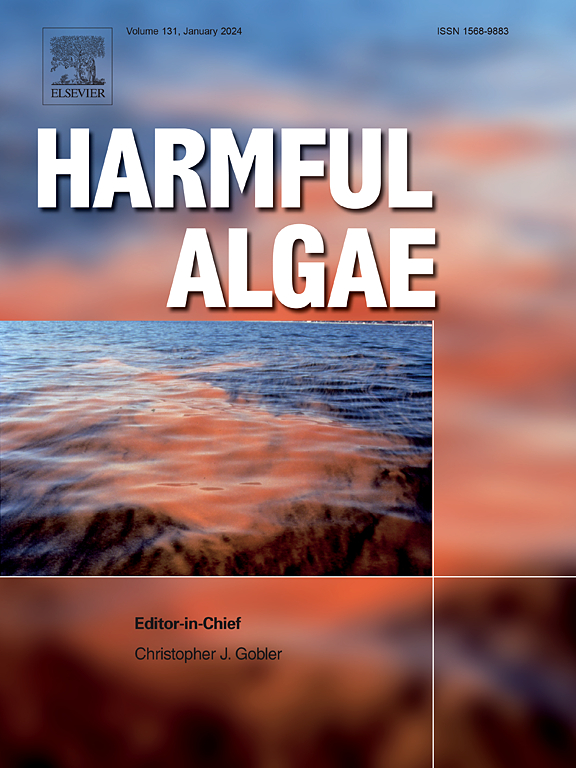Three-dimensional micro-mapping of microorganisms in the plastisphere using laser scanning confocal fluorescence microscopy
IF 4.5
1区 生物学
Q1 MARINE & FRESHWATER BIOLOGY
引用次数: 0
Abstract
We investigated the attachment patterns of microorganisms within plastispheres on plastic surfaces through three-dimensional (3D) micro-mapping of the plastisphere using multichannel laser scanning confocal fluorescence microscopy (DNA staining, chlorophyll autofluorescence, exopolysaccharides staining, and reflection). This approach allowed us to focus on information derived from the 3D structures of the plastisphere. Four-channel observations of four types of plastics—polyethylene terephthalate (PET), polyvinyl chloride (PVC), polymethyl methacrylate (PMMA), and polycarbonate (PC)—and glass plates immersed in coastal Sagami Bay for 10 days revealed the layered 3D structure of plastispheres composed mainly of diatoms and bacteria. Some dinoflagellates were also observed in the plastispheres. Morphological characteristics and chlorophyll content indicated that the observed dinoflagellates were in a vegetative form and included potentially toxic and/or red-tide-causing harmful dinoflagellates. This reaffirms previous concerns about environmental changes caused by toxic dinoflagellates captured on plastics and drifting in the ocean as hitchhikers, thereby spreading over a wider area than their original dispersion. Quantitative analysis of the 3D micro-mapped plastispheres suggested that a biofilm layer a few micrometers thick was required for dinoflagellates to attach to the plastic surface. Since extracellular polymeric substances (EPS) may be associated with the stickiness of the plastisphere, we performed five-channel observations, including exopolysaccharide staining to label EPS. These results suggested that the viscosity of EPS was responsible for these dinoflagellates’ attaching to plastic surfaces. These results provided a new perspective on the potential for the formation of plastispheres containing dinoflagellates.

利用激光扫描共聚焦荧光显微镜对塑料球中的微生物进行三维显微定位
我们利用多通道激光扫描共聚焦荧光显微镜(DNA染色、叶绿素自身荧光、外多糖染色和反射)对塑料球进行三维(3D)微成像,研究了塑料球内微生物在塑料表面的附着模式。这种方法使我们能够专注于从塑性球的3D结构中获得的信息。对聚对苯二甲酸乙二醇酯(PET)、聚氯乙烯(PVC)、聚甲基丙烯酸甲酯(PMMA)和聚碳酸酯(PC)四种塑料和玻璃板进行了为期10天的四通道观察,揭示了主要由硅藻和细菌组成的塑料球的分层三维结构。在塑料球中还观察到一些鞭毛藻。形态特征和叶绿素含量表明,所观察到的鞭毛藻为营养形态,包括潜在毒性和/或引起红潮的有害鞭毛藻。这再次证实了先前的担忧,即塑料捕获的有毒鞭毛藻在海洋中作为搭便车者漂流,从而传播到比原来更广泛的区域,从而引起环境变化。三维微映射塑料球的定量分析表明,鞭毛藻附着在塑料表面需要几微米厚的生物膜层。由于细胞外聚合物(EPS)可能与塑料球的粘性有关,我们进行了五通道观察,包括胞外多糖染色来标记EPS。这些结果表明,EPS的粘度是这些鞭毛藻附着在塑料表面的原因。这些结果为含有鞭毛藻的塑料球的形成提供了一个新的视角。
本文章由计算机程序翻译,如有差异,请以英文原文为准。
求助全文
约1分钟内获得全文
求助全文
来源期刊

Harmful Algae
生物-海洋与淡水生物学
CiteScore
12.50
自引率
15.20%
发文量
122
审稿时长
7.5 months
期刊介绍:
This journal provides a forum to promote knowledge of harmful microalgae and macroalgae, including cyanobacteria, as well as monitoring, management and control of these organisms.
 求助内容:
求助内容: 应助结果提醒方式:
应助结果提醒方式:


